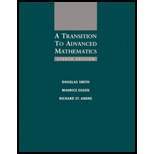
a.
Prove this by using generalized PMI and show that the equation or inequality is false.
a.
Explanation of Solution
Given :
It is given in the question that
Concept Used:
In this we have to use the concept of sets,induction and PMI.
Proof:
Assume there is a natural number
Then,
By the PMI,
Example for when the inequality y is false:
For
b.
Prove this by using generalized PMI and show that the equation or inequality is false .
b.
Explanation of Solution
Given :
It is given in the question that
Concept Used:
In this we have to use the concept of sets,induction and PMI.
Proof:
Assume there is a natural number
Then,
By the PMI,
Example for when the inequality is false:
For
c.
Prove this by using generalized PMI and show that the equation or inequality is false .
c.
Explanation of Solution
Given :
It is given in the question that
Concept Used:
In this we have to use the concept of sets,induction and PMI.
Proof:
Assume there is a natural number
Then,
By the PMI,
Example for when the inequality is false:
For
d.
Prove this by using generalized PMI and show that the equation or inequality is false.
d.
Explanation of Solution
Given :
It is given in the question that
Concept Used:
In this we have to use the concept of sets,induction and PMI.
Proof:
Assume there is a natural number
Then,
By the PMI,
Example for when the inequality is false:
Foe
e.
Prove this by using generalized PMI and show that the equation or inequality is false .
e.
Explanation of Solution
Given :
It is given in the question that
Concept Used:
In this we have to use the concept of sets,induction and PMI.
Proof:
Assume there is a natural number
Then,
By the PMI,
Example for when the inequality y is false:
For
f.
Prove this by using generalized PMI and show that the equation or inequality is false .
If x > 1 is a real number,then
f.
Explanation of Solution
Given :
It is given in the question that If x > 1 is a real number,then
Concept Used:
In this we have to use the concept of sets,induction and PMI.
Proof:
Let x be an arbitrary real number greater than
Assume there is a natural number
Then,
By the PMI,
Since x was arbitrary
Example for when the inequality is false:
For
g.
Prove this by using generalized PMI and show that the equation or inequality is false .
g.
Explanation of Solution
Given :
It is given in the question that
Concept Used:
In this we have to use the concept of sets,induction and PMI.
Proof:
Assume there is a natural number
Then,
By the PMI,
Example for when the inequality y is false:
For
h.
Prove this by using generalized PMI and show that the equation or inequality is false .
h.
Explanation of Solution
Given :
It is given in the question that
Concept Used:
In this we have to use the concept of sets,induction and PMI.
Proof:
Assume there is a natural number
Then,
By the PMI,
Example for when the inequality is false:
For
i.
Prove this by using generalized PMI and show that the equation or inequality is false .
For all
i.
Explanation of Solution
Given:
It is given in the question that ifall
Concept Used:
In this we have to use the concept of sets,induction and PMI.
Proof:
The sum of the interior angles of a triangle is 180°.
Assume there is a natural number
The sum of the interior angles of a polygon of
By the PMI,the prove is done.
Example for when the inequality is false:
For

j.
Prove this by using generalized PMI and show that the equation or inequality is false .
j.
Explanation of Solution
Given :
It is given in the question that
Concept Used:
In this we have to use the concept of sets,induction and PMI.
Proof:
Assume there is a natural number
Then,
By the PMI,
Example for when the inequality is false:
For
Want to see more full solutions like this?
Chapter 2 Solutions
A Transition to Advanced Mathematics
 Elements Of Modern AlgebraAlgebraISBN:9781285463230Author:Gilbert, Linda, JimmiePublisher:Cengage Learning,Algebra & Trigonometry with Analytic GeometryAlgebraISBN:9781133382119Author:SwokowskiPublisher:Cengage
Elements Of Modern AlgebraAlgebraISBN:9781285463230Author:Gilbert, Linda, JimmiePublisher:Cengage Learning,Algebra & Trigonometry with Analytic GeometryAlgebraISBN:9781133382119Author:SwokowskiPublisher:Cengage Algebra for College StudentsAlgebraISBN:9781285195780Author:Jerome E. Kaufmann, Karen L. SchwittersPublisher:Cengage Learning
Algebra for College StudentsAlgebraISBN:9781285195780Author:Jerome E. Kaufmann, Karen L. SchwittersPublisher:Cengage Learning
 College AlgebraAlgebraISBN:9781305115545Author:James Stewart, Lothar Redlin, Saleem WatsonPublisher:Cengage Learning
College AlgebraAlgebraISBN:9781305115545Author:James Stewart, Lothar Redlin, Saleem WatsonPublisher:Cengage Learning




